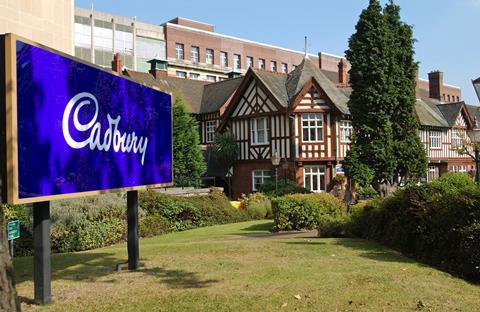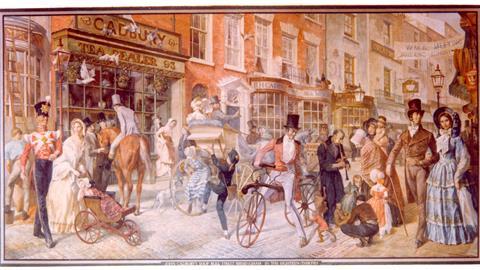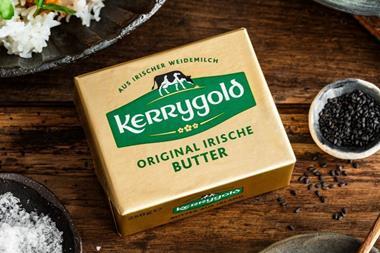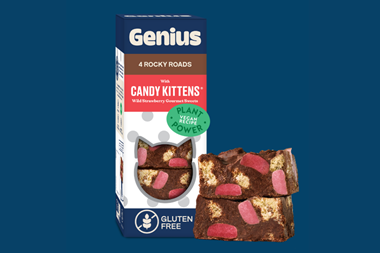As Cadbury celebrates its 200th anniversary, we look back on the success of its controversial acquisition and its future direction
From the moment the train pulls into Bournville Station, it’s clear you’re in Cadbury country. The station’s fences and lampposts have been painted Dairy Milk purple and the area retains the ‘model village’ charm planned and paid for by George Cadbury back in 1893.
But on Bournville Lane, the picture postcard tranquillity is broken as three articulated lorries rumble past and follow the ‘Goods Inwards’ signs, turning into the Cadbury factory. It’s a timely reminder that this is the home of a huge international business.
Cadbury was already the world’s second-largest confectionery company when US giant Kraft succeeded with a hostile takeover in 2010 amid fierce resistance from workers, trade unions, the media and even the UK government. Peter Mandelson, then business secretary, told Kraft it would face “huge opposition” from the government over its attempt to make a “fast buck”.
Kraft made an official stock market announcement that the UK would be a “net beneficiary in terms of jobs” and promised that, were the deal to go through, it would keep open Cadbury’s Somerdale factory near Bristol. Just a week later the plant was closed, resulting in the loss of 500 jobs.

The volte-face led to censure from the Panel on Takeovers & Mergers, resulting in a revamp of the rules governing foreign takeovers of UK companies.
But while the takeover left a bad taste in the mouth at the time, Cadbury is still the nation’s favourite chocolate. UK value sales now stand at £2.1bn [NIQ], up from an estimated £1.4bn at the time of the acquisition.
And with Cadbury celebrating its 200th anniversary this year, has enough water now passed under the bridge to consider if Kraft’s takeover has been a good thing? How successful has it been as an acquisition for Kraft? How has it affected Cadbury’s famed social ideals? And what does the future hold amid concerns over rising obesity levels and sustainability concerns?
A commercial success
Defining success is difficult at the best of times. It becomes doubly difficult when the company is subsumed into a global multi-category manufacturing and processing conglomerate – and then spun off two years later into a new snack food business, with the 2012 creation of Mondelez combining Cadbury with Milka, Toblerone, Oreo and other Kraft brands.
So, what does success look like to Mondelez? UK MD Louise Stigant says: “There are the financials of it. That will be about growth. But you only get that, frankly, if you engage your consumers. So, what’s the input versus the output to growth? If financial success is the outcome, the inputs are that people love and [still] want to buy Cadbury chocolate beyond others.”
Cadbury by the numbers
5.5million
blocks of chocolate produced at Cadbury’s Bournville site every day.
400 million
Chocolate buttons produced at Bournville every day
4,000+
People employed by Cadbury in the UK
9
Sites across the country (six factories and three R&D centres) dedicated to confectionery
30+
Countries where Cadbury chocolate is sold
10.7%
Year on year increase in UK retail sales values in the past 12 months
£900m
Generated by Mondelez International for the UK economy in 2021
Source: Mondeléz International and The Grocer Britain’s Biggest Brands
NIQ’s latest figures show Cadbury’s value sales hit £2.1bn last year in grocery (excluding the discounters) [52 w/e 30 December 2023]. This is an increase of £199m, or 10.7%. Sales growth has been accompanied by investment of £272m into the five Mondelez UK manufacturing sites. Some £80m of that has gone into Bournville since 2014, resulting in a 30% increase in efficiency, says Stigant.
And crucially “that’s allowed us to grow, and allowed us to bring back production to the UK, and specifically to Bournville, on some really key parts of our [Cadbury brand] portfolio”, says Stigant.
Having previously been “significantly more expensive in making chocolate in Bournville versus our competitors or other Cadbury-owned plants across the globe”, with investment in automation, Bournville now produces 5.5 million blocks of chocolate, 400 million chocolate buttons and a million Wispa bars in a day. “Most of our chocolate sold in the UK now comes from Bournville, which is a really good place to be,” Stigant adds.
The only downside of this automation is that the move didn’t create any new UK jobs. Cadbury’s UK workforce has stayed broadly static since the takeover at about 4,000 employees. Nonetheless, Stigant believes Mondelez’s ownership has been “a commercial success. And I think it’s been a success for the brand as well. I really think that’s an important point: it’s only a commercial success because we’ve done a great job on the brand.”
Kantar BrandZ data backs this up. The value of the Cadbury brand grew by 51% from 2017 to 2022. Perceptions of the brand as ‘making people’s lives better’ have also grown by 103% during this timeframe, with consumers 44% more likely to be proud to be seen as users of Cadbury chocolate. marketing seems to be playing an important role, too – Cadbury’s 2022 Christmas ad campaign was the most effective of those tested by Kantar in the UK.
NPD has also been crucial, with more than 20 new Cadbury products hitting shelves in the past year alone, bringing its portfolio count to over 630. The latest is its new Creme Egg sharing bar, launched in December, while two of the top three bestselling new standard chocolate singles in 2022 were also Cadbury lines.

Shaun Browne, chairman of consumer, food & retail, Europe, at Houlihan Lokey, believes “Mondelez should be reasonably satisfied with the growth the Cadbury brand has achieved since acquisition. The Cadbury brand market share of the UK confectionery market may have slipped a little since the acquisition, but this is most likely because Mondelez has used the strength of the Cadbury brand in the UK to grow other brands such as Clif, Grenade and Milka.”
Clive Black, vice-chairman at Shore Capital, agrees “Mondelez has been a sound player” but also sounds a note of caution. “Something has been lost in Cadbury being a subsidiary, rather than a standalone British entity,” he says. “However, it is for now a core part of the group’s offering, and so long as that remains the case, it should gain backing.”
‘An amazing company to work for’
As well as investment, costs have been slashed. Browne notes that “at the time of the acquisition, Kraft announced expected $750m of annual cost savings by the end of year three. In its 2013 Annual Report, Kraft announced it was a year ahead of plan and had achieved $800m in annual cost savings.
Inevitably, that’s had an impact on the culture. Maxine Knowles, who worked in numerous roles on the factory floor from 1988 to 2016, recalls that “Cadbury, as it was [pre-takeover], was an amazing company to work for. Very good pay, they looked after their people, they had the discounted houses for employees, we had the social club. I was very proud to work for Cadbury. I wouldn’t have stayed so long otherwise.”
Following the takeover, though, “things changed subtly”, she adds. “The previous approach was, if you get your job done, we’ll leave you alone. Then the new managers came along and had different ideas.”
Faced with reapplying for the job she’d done for so long, Knowles decided to “take the [redundancy] money and run”, she says. “The few people I know who still work there are not very happy. They don’t really enjoy their jobs any more because it’s totally different.”
Knowles’ assessment of her early years with Cadbury chimes with the long-held image of the company as a byword for conscientious capitalism. Richard and George Cadbury, who took over the business from their father in 1861, honoured the family’s Quaker ideals by treating employees and the surrounding area well.
This resulted in a raft of works, including developing the Bournville estate as a model village to give employees better living conditions. There was also a children’s playground, tennis courts, swimming pools and more, while Cadbury became one of the first companies to allow employees half a day off work on Saturdays. In 1902, 30% of the company’s capital expenditure was spent on workers’ welfare.
On the ‘Our Story’ section of the Cadbury website it claims: “We’ve come a long way in 200 years, but one thing that will never change is the generous spirit we bring to everything we do.”
Stigant says she “genuinely believes” this is still the case. “We talk about it in the business all the time. We question ourselves around: what more could we do? I think it’s in the genes almost. You’re in Bournville, you can’t avoid being impacted by what you see.”
The company has built a culture of belonging and offers many opportunities for learning and career development, she says, and also cites recent investment with FareShare on two kitchens that turn wasted product into meals that are distributed across local communities, donations to GroceryAid, and other charitable endeavours.
There is also the Cadbury Foundation, which was founded in 1935 and continues to support Cadbury employees and the local community through volunteering, funding and other work. Today, it is solely funded by the UK arm of Mondelez and, in the past 10 years, has invested £15m in local communities around Cadbury’s UK sites.
The challenge of obesity
Doing good takes many guises, of course. And on the Mondelez website it states that its purpose is to “empower people to snack right”. Early attempts at reformulation fell flat, with Dairy Milk 30% less sugar scrapped after racking up just £1.9m in sales in 2021. In December 2022, Mondelez announced “ground-breaking” new tech that could reduce the sugar and fat in its snacks by up to 75%. A raft of “healthier” takes on Cadbury favourites was floated, but Stigant says that “we can’t commit to specific timelines, and nothing is immediately planned” on that front. Higher hopes surround Dairy Milk Fruitier & Nuttier, a range of four HFSS-compliant SKUs that allow Cadbury to retain a presence in prominent retail display locations.
“We recognise the challenge of obesity and the important part we play in that,” says Stigant. Mondelez’s strategy takes in reformulation, education and portion control, on which the company has “done lots of work”, reducing “products that are typically bought by parents for children to less than 100 calories per portion”.

Of course, one person’s portion control is another’s shrinkflation, and Stigant acknowledges that “economically, it’s very challenging for people out there… we’re trying to balance how we navigate that carefully”.
On the education front, she draws attention to Cadbury’s Health for Life programme, a partnership in Birmingham that goes into schools and communities to “really push” knowledge around “how you create a balanced diet”. Mondelez has invested £5m into the programme over the past 10 years.
James Toop, CEO of campaign group Bite Back, says: “Brands like Cadbury – which are almost totally reliant on sales of unhealthy food – have absolutely no place in schools or community education programmes. Rather than prioritise child health, they choose to use their profit, made from sales of junk food, to heavily market their unhealthy products.”
Fair treatment and pay
Sustainability and ethics also need to be front and centre in Cadbury’s thinking. The new European anti-deforestation regulations will require companies to fully trace their cocoa supply chains down to farm level. According to Julian Oram, senior director at Mighty Earth, this “represents an opportunity for chocolate manufacturers to radically rethink their business models and invest in farmers by paying them a living income”.
Oram points out that Mondelez “ducked out” of the 2023 Chocolate Scorecard, an annual sustainability survey that covers more than 90% of the industry, and says the company “needs to be more transparent about all areas of sustainability”.
Cadbury also pulled out of the Fairtrade scheme in 2016 in favour of its own sustainability programme, Cocoa Life. Yet in December, a report from Ethical Consumer found that just 17 out of 82 confectionery brands sourced their chocolate from suppliers that paid farmers enough to live on. Mondelez was not one of them.
More on confectionery:
-
Nestlé adds quartet of ice cream-inspired confectionery
-
Mars Wrigley’s Matt Boulter on Tupac, nosebleeds and legacy
-
What Mondelez risks by vehemently protecting its purple reign
-
Cadbury Creme Egg nails return of ‘how do you eat yours?’
Mondelez has stated that it aims to source all its chocolate through its Cocoa Life programme by 2025 and increase the number of farmers in the programme to 300,000 by 2030. “We’re completely committed to making sure there’s fair treatment and pay for anybody who we rely on to make our products,” says Stigant. She adds that, by 2030, Mondelez will have invested a billion dollars in Cocoa Life.
Oram, however, criticises the Cocoa Life scheme’s “vague goals”. And Mike Rogerson, a lecturer in operations management at Sussex University and an expert on modern slavery in supply chains, says that “ultimately, the industry’s inability to deal adequately with the problem of modern slavery and child labour in its supply chains is the result of individual and collective failures of the big chocolate firms”.
He does, however, point out we should not mythologise the business under its previous, UK-based ownership. “Cadbury had known about modern slavery issues in its cocoa supply chains as early as 1905… I find it extremely hard to believe that Mondelez bought a major chocolate producer doing excellent work on modern slavery and let that standard collapse.”
Cadbury by the numbers
£272m
Invested in manufacturing capabilities from 2012 to 2021
30%
Increase in production efficiency at Bournville since 2014
£15m
Invested in UK neighbourhoods by the Cadbury Foundation in the past 10 years
11
Research institutions that have formed PhD partnerships with Mondelez
17
PhD students currently engaged in research into the future of snacking
£2.5m
Invested into graduate schemes, placements and apprenticeship programme since 2017
Source: Mondelez International and The Grocer Britain’s Biggest Brands
Debate and opinions
In the end, the question of whether Kraft’s takeover has been “a good thing” depends on one’s definition of good. Knowles, for example, is clear when asked if she thinks this is the case.
“No,” she says. “I am biased, but I think if you ask any of my old work colleagues the answer would be the same. I’d probably still be working there [if it wasn’t for the takeover].”
Yet Stigant thinks “the judgement should be about what we’ve done with the business. I think there’s a story of investment, of bringing chocolate back to the UK, of creating a business that’s thriving. I look at it and say: ‘I think we’ve done a great job, actually.’”
Shore Capital’s Black, meanwhile, takes a position somewhere between the two. “A totemic corporate takeover will always create debate and divide opinions. Inevitably, nostalgia kicks in, and something has been lost through the American corporatisation of Cadbury. However, that’s business. At least Cadbury is alive and kicking in the UK, unlike some labels that have not been so fortunate.”




















No comments yet